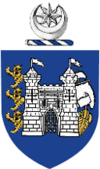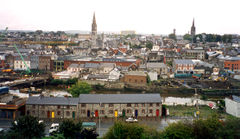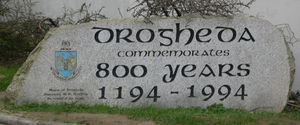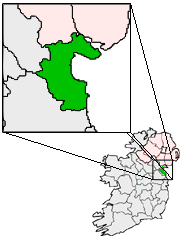Drogheda
| Drogheda Droichead Átha |
||
 |
||
|---|---|---|
 |
||
| Location | ||
|
||
| Irish grid reference O088754 |
||
| Statistics | ||
| Province: | Leinster | |
| County: | County Louth | |
| Elevation: | ||
| - Minimum: | 1 m (3.3 ft) | |
| - Maximum: | 23 m (75 ft) | |
| Population (2006) | 35,085[1] | |
| Website: www.droghedaboro.ie | ||
Drogheda (pronounced /ˈdrɒhədə, ˈdrɔːdə/) (from Irish: Droichead Átha meaning "bridge of the ford") is an industrial and port town in County Louth on the east coast of Ireland, 56 km (35 mi) north of Dublin. Including suburbs and environs, Drogheda is the third largest town (excluding the cities) in Ireland, with a population of approximately 35,000 inhabitants.
As the River Boyne (still) divides the dioceses of Armagh and Meath, Drogheda was founded as two separate towns, Drogheda-in-Meath (for which a charter was granted in 1194) and Drogheda-in-Oriel (or 'Uriel') as County Louth was then known. In 1412 these two towns were united and Drogheda became a 'County Corporate', styled as 'the County of the Town of Drogheda'. Drogheda continued as a County Borough until the setting up of County Councils, through the enactment of the Local Government (Ireland) Act 1898, which saw all of Drogheda, including a large area south of the Boyne, become part of an extended County Louth. With the passing of the County of Louth and Borough of Drogheda (Boundaries) Provisional Order, 1976, County Louth again grew larger at the expense of County Meath. The boundary was further altered in 1994 by the Local Government (Boundaries) (Town Elections) Regulations 1994. The 2007-2013 Meath County Development Plan recognises the Meath environs of Drogheda as a primary growth centre on a par with Navan.
In recent years Drogheda's economy has diversified from its traditional industries, with an increasing number of people employed in the retail, services and technology sectors. The town also has a community of independent artists and musicians who have been looking to the local economy rather than Dublin for employment.
Contents |
History

Hinterland
| Historical populations | ||
|---|---|---|
| Year | Pop. | %± |
| 1813 | 16,123 | — |
| 1821 | 18,118 | 12.4% |
| 1831 | 17,365 | −4.2% |
| 1841 | 17,300 | −0.4% |
| 1851 | 16,810 | −2.8% |
| 1861 | 14,722 | −12.4% |
| 1871 | 13,510 | −8.2% |
| 1881 | 12,297 | −9.0% |
| 1891 | 11,873 | −3.4% |
| 1901 | 12,760 | 7.5% |
| 1911 | 12,501 | −2.0% |
| 1926 | 12,716 | 1.7% |
| 1936 | 14,494 | 14.0% |
| 1946 | 15,715 | 8.4% |
| 1951 | 16,779 | 6.8% |
| 1956 | 17,008 | 1.4% |
| 1961 | 17,085 | 0.5% |
| 1966 | 17,908 | 4.8% |
| 1971 | 20,095 | 12.2% |
| 1981 | 23,615 | 17.5% |
| 1986 | 24,681 | 4.5% |
| 1991 | 24,656 | −0.1% |
| 1996 | 25,282 | 2.5% |
| 2002 | 31,020 | 22.7% |
| 2006 | 35,090 | 13.1% |
| See www.cso.ie/census and www.histpop.org for post 1821 figures, 1813 estimate from Mason’s Statistical Survey For a discussion on the accuracy of pre-famine census returns see JJ Lee “On the accuracy of the Pre-famine Irish censuses Irish Population, Economy and Society edited by JM Goldstrom and LA Clarkson (1981) p54, in and also New Developments in Irish Population History, 1700-1850 by Joel Mokyr and Cormac O Grada in The Economic History Review, New Series, Vol. 37, No. 4 (Nov., 1984), pp. 473-488. | ||
The town is situated in an area with an abundance of archaeological monuments dating from the Neolithic period onwards, of which the large Passage Tombs of Newgrange, Knowth and Dowth are probably the best known.[2] The remarkable density of archaeological sites of the prehistoric and Early Christian periods uncovered in recent years in the course of development, notably during construction of the Northern Motorway: Gormanston to Monasterboice, or 'Drogheda Bypass', have shown that the hinterland of Drogheda has been a settled landscape for millennia.[3]
Town beginnings
However, Bradley, in his 1978 study of the history and archaeology of the town, stated that "neither the documentary nor the archaeological evidence indicates that there was any settlement at the town prior to the coming of the Normans".[4] The results of the numerous and often large-scale excavations carried out within the area of the medieval town in the past ten years appear to have confirmed this statement.[5]
The earliest monument in the town is the motte-and-bailey castle, now known as Millmount Fort, which overlooks the town from a bluff on the south bank of the Boyne, and which was probably erected by the Norman Lord of Meath, Hugh de Lacy sometime before 1186. The earliest known town charter is that granted to Drogheda-in-Meath by Walter de lacy in 1194.[6] Sometimes it was also spelled "Tredagh".
Drogheda was an important walled town in the English Pale in the medieval period. It frequently hosted meetings of the Irish Parliament at that time. The parliament was moved to the town in 1494 and passed Poyning's Law a year later. According to R.J.Mitchell in John Tiptoft, Earl of Worcester, the Earl of Desmond and his two youngest sons (still children) were executed there on Valentine's Day, 1468, on orders of the Earl of Worcester. It later came to light (see Robert Fabyan,"The New Chronicles of England and France"), that the Queen herself was implicated in the orders given. The town was besieged twice during the Irish Confederate Wars. On the second occasion it was taken by Oliver Cromwell in September 1649, as part of the Cromwellian conquest of Ireland and it was the site of an infamous massacre of the Royalist defenders.
Later events
The Earldom of Drogheda was created in the Peerage of Ireland in 1661.
The Battle of the Boyne, 1690, occurred some 6 km (4 mi) west of the town, on the banks of the River Boyne, at Oldbridge.
In 1837 the population of Drogheda area was 17,365 of whom 15,138 lived in the town.[7]
Town arms
A Norman element on Drogheda's coat of arms is its centrepiece, St. Laurence's Gate. The three lions which flank the Norman barbican and the star and crescent, similar to those on the coat of arms of Portsmouth, are taken from Richard The Lionheart's coat of arms who gave both towns their charters. On the other side of the barbican is a ship denoting Drogheda's status as an important port. The town's motto Deus praesidium, mercatura decus translates as "God our strength, merchandise our glory".[8]
A local myth has it that the star and crescent were included in the town arms after the Ottoman Empire (predecessor to the Republic of Turkey) sent ships laden with food to Drogheda during the Irish famine. However, there are no records of this with the Drogheda Port, and the star and crescent predate the famine.[9]
20th century
In 1921 the shrunken head of Saint Oliver Plunkett, who was executed in London in 1681, was put on display in the church. This church is located in west street which is the main street in the town. For further information about St. Oliver and events, see web-site: http://www.saintoliverplunkett.com
Arts and entertainment
Drogheda has a thriving arts scene, across many sectors.
Theatre and performing arts
The town hosts the annual Samba festival every summer, where Samba bands from around the world converge on the town for a week of drumming and parades. It is also home to the Calipo theatre company which specialises in multi-media productions and has achieved considerable success in Ireland and abroad.
The town also supports one of the largest and most successful youth theatres in Ireland (Droichead Youth Theatre) which has toured to Belfast, London, Italy, and Sweden. The addition of the Little Duke Theatre company in Duke Street, in the old Julian Blinds building, adds to this scene. The Municipal Centre in Stockwell Street acts as a base for most of the town's artists, under the umbrella of the Droichead Arts Centre, and featuring a gallery space and a theatre. The former Garda (Police) station in West Street is now a satellite site of the Droichead Arts Centre. This site is called Barlow House.
Drogheda also boasts a long tradition of its very own pantomime, which is usually held in January/February of each year. These productions have been going for roughly 60 years and are considered a great source of recreaction for the town. Many locations have been used for staging productions (most notably the old Parochial Centre) although the Pantomime Society have found a new and more permanent home in the form of the T.L.T. (Tommy Leddy Theatre), located beside the Sound Shop in the East Coast Business Park.
Music
Contemporary Music
Drogheda has also been the scene for some of the most important contemporary music events in Ireland. Louth Contemporary Music Society invited the US composer Terry Riley to perform in Drogheda in 2007, Arvo Pärt's first Irish commission and visit to the country was in Drogheda in February 2008, Michael Nyman performed in Drogheda in May 2008, John Tavener's Temenos festival was held in October 2008 and the Russian composer Alexander Knaifel was the focus of a portrait concert as part of the Drogheda Arts festival on 1 May 2009.[1]
Drogheda Composers
The composer and Aosdána member, Michael Holohan, has lived in Drogheda since 1983. His compositions have been performed and broadcast both at home and abroad. Career highlights in Drogheda include 'Cromwell' 1994 (RTECO), 'The Mass of Fire' 1995 (RTE live broadcast) and 'No Sanctuary' 1997 (in the Augustinian Church with Nobel Laureate and poet Seamus Heaney). 'Fields of Blue and White', a CD of his piano music was launched in the National Concert Hall in 2009 and the concert pianist,Therese Fahy, was the recording artist. A keen supporter of the arts he is also a former chairman of the Droichead Arts Centre.([2]).
Live Music
Drogheda has a thriving live music scene at a variety of venues.
Brass Bands
Drogheda has a number of brass bands and is home to the National Brass Band Champions of Ireland The Drogheda Brass Band 2007,2008,2009 and The Lourdes Brass Band South Of Ireland Band Champions for three consecutive years, 2006, 2007, 2008.
Visual arts
October 2006 saw the opening of the town's first dedicated Municipal Art Gallery and visual arts centre, the Highlanes Gallery, housed in the former Franciscan Friary on St. Laurence Street. The Highlanes Gallery houses Drogheda's important municipal art collection which dates from the 17th century as well as visiting exhibitions in a venue which meets key international museum and gallery standards. Drogheda's most famous visual artist was the abstract expressionist painter Nano Reid (d.1981). Artists working today in the town and its environs include Raphael Hynes, Richard Moore, Liam O'Broin,Teddy Doyle, Padhraic Murphy, John Moloney and Paul McCann.
Literature
Drogheda experienced a rennaisance in literature in the 1980s. National award-winning poets include Angela Greene (r.i.p.), Susan Connolly, Marie MacSweeney, Joseph Woods and Barbara Smith. Other published poets and writers include John O'Rourke, Roger Hudson, Stephen Downes, Dixie Nugent, Shane Fagan and Terry McHugh. There are many published writers on academic and local history subjects and these include Anthony Murphy, Gabriel Cooney, John McCullen, Geraldine Stout, Ricky Gerrard, Ned McHugh and Deirdre Russell. Oisin Mc Gann is one of the best known writers of children's literature in the country. Noted playwrights include Darren Thornton (Calipo Theatre Co.) and Declan Gorman (Upstate Theatre Co.).
Popular culture
The estate in the famous series "The Thorn Birds" was named after the town of Drogheda.
Drogheda today

With the expansion of the Irish economy in the 1990s, during the "Celtic Tiger" years, Drogheda became one of the main secondary locations for people who work in Dublin to buy a house, as property prices in the capital became prohibitive for many first-time home buyers. This was aided by the expansion of transport infrastructure in the direction of Drogheda i.e. the Swords and Balbriggan bypasses, the Boyne River Bridge and the increased number of commuter trains serving the town. Partly as a result, the downtown area of Drogheda has redeveloped, and two large shopping centres have opened, while several national and international retailers have opened stores. In 2007 the partial pedestrianisation of the town's main street, West Street, was completed.This was not a success from a business point of view and West St. has become a ghost street.
On the south quay in the space of the former Lakeland Daries premises (an old industrial area), the Scotch Hall Shopping Centre and the D hotel was completed in November 2005. A new pedestrian bridge extends from the north quay, at Mayoralty Street, into the complex. Phase two of the development, which will shortly commence construction, will extend further down along the river front, on the site of the former Irish Oil Cake works. It will have an extension to the Shopping Centre and Hotel, new apartments, cinema, and a riverside plaza.
Transport, communications & amenities

Drogheda is located close to the M1 (E1 Euro Route 1) (main Dublin - Belfast motorway). The Boyne River Bridge carries traffic from the M1, across the River Boyne, 3 km west of the town. It was opened on June 9, 2003 and is the longest cable stayed bridge in Ireland.
Drogheda acquired rail links to Dublin in 1844, Navan in 1850 and Belfast in 1852. Passenger services between Drogheda and Navan were ended in 1958, however the line remains open for freight (Tara Mines/Platin Cement) traffic. In 1966 Drogheda station was renamed "McBride". Drogheda railway station opened on 25 May 1844.[10] Defined by its location as the last crossing point on the Boyne before it reaches the sea, Drogheda has seven bridges in its vicinity.
Local economy
The local economy of Drogheda, like that of many other towns in Ireland, is changing rapidly. The old industries based around linen and textiles, brewing, shipping and manufacturing have now disappeared or are in decline. And in recent times during the recession business has slowed and Drogheda faces an increase in unemployment numbers.
There are still a number of large employers in the town including:
- Flogas, a national gas distributor
- Natures Best, a fresh food processor
- Hilton Foods, a meat processor
- Boyne Valley Foods, a producer and distributor of jams and honey
- Irish Cement, Ireland's largest cement works
- International Flavours & Fragrances (IFF), a producer of perfumes and food fragrances
- Becton Dickinson (BD), a manufacturer of medical syringes and associated equipment
Recently additions to the local economy include:
- IDA Business & Technology Park: a 25 hectare (63 acre) with direct access onto the Dublin / Belfast motorway developed and landscaped for the needs of both the IT, financial and internationally traded services sectors.
- International Fund Services, a leading provider of fund accounting and administration services to the hedge fund industry globally, is to establish a hedge fund administration operation in Drogheda, Co. Louth with the creation of up to 235 jobs.
- Eight enterprise incubation units for high tech startup companies are provided in the Milmount complex.
The opening of the Drogheda bypass has led to the development of 2 large retail parks adjacent to the motorway, either side of the Boyne cable bridge. On the northside, is the M1 Retail Park and on the southside is the Drogheda Retail Park.
Media
The local newspapers are the Drogheda Leader, and The Drogheda Independent. The Drogheda Independent also publishes a newspaper called the Drogheda People. The main newspapers are known locally as "The D.I' and 'the Leader'. Both principal newspapers are published every Wednesday. The headquarters of The Drogheda Independent are on Shop Street and The Drogheda Leader's offices are on Laurence Street.
The local radio station is LMFM, broadcasting on 95.8 FM. The headquarters of LM-FM are on Marley's Lane on the south side of the town.
Sport
- Soccer: In December 2005 the town's soccer team, Drogheda United, won the FAI Cup for the first time. In 2006 Drogheda United won the Setanta Cup. In 2007, Drogheda United won the League of Ireland for the first time in the club's history. Drogheda United FC's brother team is Trabzonspor from Turkey. Both of two team's colours are claret red and blue.
- Rugby: Local team Boyne RFC was formed in 1997 from the amalgamation of Delvin RFC and Drogheda RFC. As of 2010[update], the Men's 1st XV team plays in the Leinster J1 1st division. Drogheda is also home to many rugby playing schools, including St.Mary's who are the under 14 Leinster rugby champions.
Town twinning
 - Bronte, Italy
- Bronte, Italy
People
Football players
- Nick Colgan, goalkeeper for Sunderland and the Republic of Ireland men's national team.
- Ian Harte, full-back for Blackpool F.C former Leeds United (UK), Levante (Spain) & Sunderland (UK) player and the Republic of Ireland national team.
- Gary Kelly, football player and charity campaigner.
- Sean Thornton, midfielder Leyton Orient in England and former Republic Of Ireland under 21 national team.
- Kevin Thornton, midfielder Coventry City F.C. in England and former Republic Of Ireland under 21 national team.
- Steve Staunton, midfielder former Republic Of Ireland national team.
Others
- Pierce Brosnan, famous Hollywood actor, appeared as James Bond in four Bond films and starred in Mama Mia and Dantes Peak.
- Tommy Byrne, former racing driver, raced briefly in Formula 1 in 1982
- Tony Byrne, bronze medal winner for Ireland 1956 Summer Olympics in Melbourne, Australia in the lightweight division.
- Eamonn Campbell, member of The Dubliners, Guitarist and Music Producer,
- Susan Connolly, Poet. Dedalus Press and Shearsman Books.
- James Cullen, mathematician who discovered what are now known as the Cullen numbers.
- Deirdre Gogarty, 1997 Women's International Boxing Federation (WIBF) Featherweight Title Champion.
- Angela Greene, Poet. Patrick Kavanagh Award. Salmon Press.
- Ronan Halpin, Sculptor. National and International Exhibitions.
- Michael Holohan, Composer and member of Aosdana.
- Shane Horgan, international rugby player, Ireland national rugby union team
- Raphael Hynes. Artist, National Award R.H.A.
- Jonathan Kelly, singer-songwriter.
- Evanna Lynch, actress, starred in Harry Potter as Luna Lovegood.
- Tony Martin, Canadian social democratic legislator.
- Richard Moore, Artist
- Anthony Murphy, Journalist and Writer. The Liffey Press.
- Deirdre O'Kane, award-winning comedian.
- Eliza O'Neill (1791–1872), actress.
- John Boyle O'Reilly poet and novelist, member of the Irish Republican Brotherhood.
- Michael Scott, architect who designed Busáras and the Abbey Theatre.
- Des Smyth, Professional golfer, Vice-captain on the winning Ryder Cupteam in 2006.
- Geraldine Stout, Archaeologist and Writer. Cork University Press.
- T.K. Whitaker, former Irish economist who wrote the Programme for Economic Expansion went to school in Drogheda.
See also
- List of abbeys and priories in Ireland (County Louth)
- List of towns and villages in Ireland
References
- ↑ Census 2006
- ↑ Stout, G. 2002 Newgrange and the Bend of the Boyne. Cork University Press.
- ↑ Bennett, I. (ed) 1987-2004 Excavations : Summary accounts of archaeological excavations in Ireland. Bray.
- ↑ Bradley, J. 1978 ‘The Topography and Layout of Medieval Drogheda’, Co. Louth Archaeological and Historical Journal, 19, 2, 98-127.
- ↑ Bennett op cit.
- ↑ Bradley op cit 105
- ↑ Entry for Drogheda in Lewis Topographical Dictionary of Ireland (1837)
- ↑ http://www.ngw.nl/int/ier/d/drogheda.htm
- ↑ Murray, Ken (25 March 2010). "President tells Turks an anecdote of myth not fact". The Irish Times. http://www.irishtimes.com/newspaper/ireland/2010/0325/1224267012277.html. Retrieved 25 March 2010.
- ↑ "Drogheda station" (PDF). Railscot - Irish Railways. http://www.railscot.co.uk/Ireland/Irish_railways.pdf. Retrieved 2007-09-05.
